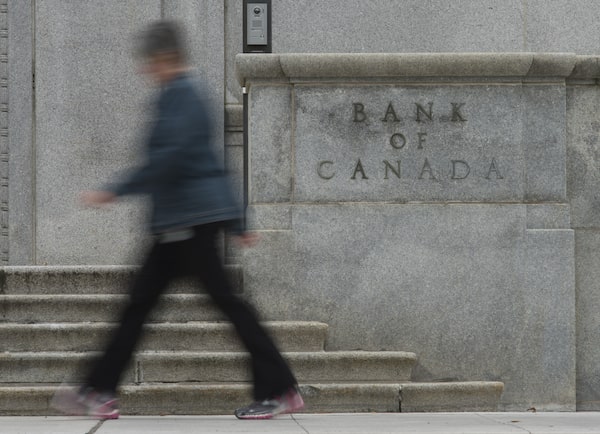
The Bank of Canada announced another oversized interest rate hike on Wednesday as it tries to put the brakes on runaway inflation.Adrian Wyld/The Canadian Press
The Bank of Canada has thoroughly convinced us that it’s serious about getting interest rates much higher, and quickly, to put the lid back on our inflation problem. Now, the job is to convince us that the strategy is working.
It surprised no one that the central bank raised its policy rate by 50 basis points (one-half percentage point) to 1.5 per cent on Wednesday – its second such oversized increase of the spring – and signalled that we likely have more of the same to come. With inflation running at a three-decade high, the bank has been unusually open about its intentions to get its key rate into at least the 2-to-3-per-cent range in relatively short order, in an effort to douse prices.
But what was a surprise was the forceful language the bank wrapped around its rate hike.
It said the Canadian economy “is clearly operating in excess demand.” It pointed to strong growth, labour shortages and rising wages, all evidence of domestic inflation pressures. It warned that inflation is likely to get worse, in the near term, before it gets better.
“That’s about as alarmist as a non-excitable bunch of central bankers would likely ever get in signalling inflation worries,” Bank of Nova Scotia economist Derek Holt said in a research note on Wednesday.
Canada’s big banks see income grow as interest rates rise
Bank of Canada has raised its benchmark interest rate to 1.5%. Here’s what that means for Canadians
But the most telling line in the five-paragraph statement was this: “The Governing Council is prepared to act more forcefully if needed to meet its commitment to achieve the 2-per-cent inflation target.”
That’s a doozy. Yes, senior central bank officials have, in the past few weeks, talked about being as forceful as necessary to wrangle inflation back to the bank’s target. But “more forcefully” goes further: Rate hikes of more than 50 basis points are now, most definitely, in play.
The overall message was that the inflation problem is serious, and the bank is very serious about fixing it. There’s no messing around here.
Which is, of course, exactly what the bank needs to sink in with Canadians. The biggest risk now is that we become resigned to high inflation, that workers start locking those expectations into their wage demands and businesses start entrenching them into their future planning. If that happens, then getting inflation under control becomes much, much more difficult, and the damage deeper and longer-lasting.
The bank must convince Canadians its actions will put inflation back in its cage. Expect the central bank to continue its tough talk on Thursday, when deputy-governor Paul Beaudry delivers the bank’s post-rate-announcement speech updating its economic views and elaborating on its rate decision. In the speech, and in the news conference that will follow – indeed, in every public statement that senior Bank of Canada officials make between now and the next rate decision in mid-July – expect the bank to hammer this home.
But it won’t be enough to just say it. The bank will have to show that its tough medicine is working. And it will need to produce evidence pretty soon if it expects to hold the confidence of Canadians.
It could help, then, that the Bank of Canada may have adopted a more pessimistic view that is entirely warranted.
For one thing, global demand is showing signs of slowing, as inflation, the war in Ukraine and COVID-related slowdowns in China weigh on activity. And Scotia’s Mr. Holt noted that Canada’s month-over-month wage growth – the most crucial indicator of domestic inflation pressures – has actually slowed in recent months.
Housing has reacted swiftly to this spring’s rate increases: Home sales slumped nearly 13 per cent in April from March, and were down 26 per cent from a year earlier.CARLOS OSORIO/Reuters
Indeed, the Canadian economy might not be as “clearly” overheated as the central bank suggests. Andrew Grantham, senior economist at Canadian Imperial Bank of Commerce, argues that outside of the housing market and a few pockets in the services sector that are suffering reopening pains, the statistics don’t show anywhere near the broad excess demand that is evident in the U.S. economy.
“The [Bank of Canada’s] statement today was trying to justify a 50-basis-point hike, and was likely setting up a further 50 basis points next month, so it had to be hawkish in tone,” he said in an e-mail on Wednesday.
If that’s the case, the Canadian economy might not need a tremendous amount of additional rate tightening to bring domestic demand back in line. The big exception, of course, being the housing market – which, for obvious reasons, is the most sensitive sector in the economy to rate hikes.
Housing has reacted swiftly to this spring’s rate increases: Home sales slumped nearly 13 per cent in April from March, and were down 26 per cent from a year earlier. Prices also stalled, and will likely go into decline as rising rates slow the market further.
That alone will take a substantial step toward correcting the country’s excess demand situation, and provide the highly visible sign of easing inflation pressures that the Bank of Canada sorely needs. But it’s also a sensitive topic for Canadian home owners, who will nervously eye falling markets.
The bank had remarkably little to say about the housing market in Wednesday’s rate announcement, allowing only that “housing market activity is moderating from exceptionally high levels.” But as the bank pivots its message to showing the public that its plan is working, the slowing housing market is going to be a crucial indicator - and a big part of the bank’s conversation.
Your time is valuable. Have the Top Business Headlines newsletter conveniently delivered to your inbox in the morning or evening. Sign up today.
 David Parkinson
David Parkinson